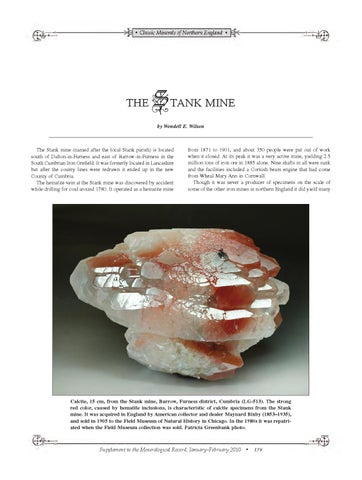THE
STANK MINE by Wendell E. Wilson
The Stank mine (named after the local Stank parish) is located south of Dalton-in-Furness and east of Barrow-in-Furness in the South Cumbrian Iron Orefield. It was formerly located in Lancashire but after the county lines were redrawn it ended up in the new County of Cumbria. The hematite vein at the Stank mine was discovered by accident while drilling for coal around 1780. It operated as a hematite mine
from 1871 to 1901, and about 350 people were put out of work when it closed. At its peak it was a very active mine, yielding 2.5 million tons of iron ore in 1885 alone. Nine shafts in all were sunk and the facilities included a Cornish beam engine that had come from Wheal Mary Ann in Cornwall. Though it was never a producer of specimens on the scale of some of the other iron mines in northern England it did yield many
Calcite, 15 cm, from the Stank mine, Barrow, Furness district, Cumbria (LG-513). The strong red color, caused by hematite inclusions, is characteristic of calcite specimens from the Stank mine. It was acquired in England by American collector and dealer Maynard Bixby (1853–1935), and sold in 1905 to the Field Museum of Natural History in Chicago. In the 1980s it was repatriated when the Field Museum collection was sold. Patricia Greenbank photo.
Supplement to the Mineralogical Record, January–February 2010 • 139
